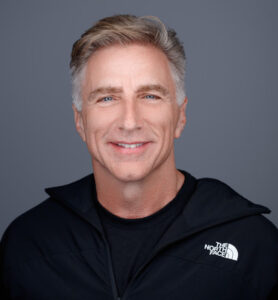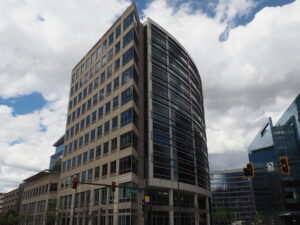 Bracken Darrell spent his first year as CEO of VF Corp., trying to stem losses at Vans, The North Face, Timberland and Dickies. On his anniversary, he has high hopes that the company’s new Denver hub can boost sales across the Americas – and conquer the problems that arose with the company’s 2019 move to the Rockies.
Bracken Darrell spent his first year as CEO of VF Corp., trying to stem losses at Vans, The North Face, Timberland and Dickies. On his anniversary, he has high hopes that the company’s new Denver hub can boost sales across the Americas – and conquer the problems that arose with the company’s 2019 move to the Rockies.
VF moved from Greensboro, NC, and created a central command center at its LoDo headquarters – with tax breaks and fanfare — to better coordinate design, supply chain, analytics and retail across the conglomerate of outdoor apparel and footwear.
Instead, it added a layer of bureaucracy and robbed VF’s brands of their autonomy, especially at The North Face, which lost most of its employees and momentum when VF moved it from Alameda, CA. The outdoor gear maker became VF’s largest division last year, but only because Vans’ sales plummeted by 25 percent, as its classic sneakers faded from style.
The Americas regional platform is modeled on one that raised The North Face sales in Asia by 30 percent last year, when most other divisions and regions stagnated or declined. “We have a change in the operating model,” Darrell, 61, told BusinessDen. “It has tended to make this place more innovative.”
Innovation helped Darrell revamp Logitech International S.A., which he led from 2013 until July 2023. The Swiss company pioneered the infrared cordless mouse, the thumb-operated trackball and wireless keyboards – all of which went from essential to ancillary when smartphones became standard. Darrell used design to revive its products and acquired makers of in-demand headsets, earpieces and gaming accessories. Logitech’s market cap rose tenfold while he was CEO.

Bracken Darrell, 62, has been CEO at VF Corp. for one year
Darrell is a serial manager who led brands such as Old Spice, Gillette, Braun Kitchen Aid and Whirlpool.
Turning around VF might be his toughest challenge yet. In the 2024 fiscal year, sales shrank 11 percent as the company posted a nearly $1 billion loss, half of which came from writing down the value of earlier acquisitions. Its shares are trading around $16 down from $100 before the pandemic. They are also down from $19 when Darrell took over, although they’ve enjoyed a bounce of 37 percent in the last two months.
Darrell lost no time. He has replaced the heads of The North Face, Vans and Timberland, which jointly make up three-quarters of sales. He changed the chiefs of finance, strategy, and human resources, brought over his design chief from Logitech and added a go-to-market chief.
VF gave up extra office space, liquidated stale inventory, sold the corporate jets and a hangar at Centennial airport and laid off 500 of the company’s 30,000 employees worldwide. With the savings, it paid down $540 million in debt. It’s still seeking subletters for the top two floors of its Wewatta Street headquarters.
“What I did in my last company over five or more years, we did here in one,” Darrell, wrote in his first annual report, issued in June. He said the new team could not only turn around VF but also “drive its long-term growth.”

VF Corp. leases the entire building at 1551 Wewatta St. in downtown Denver. (Matt Geiger/BusinessDen)
Core users who like to defy gravity give Vans and The North Face their cachet. Vans’ Off the Wall branding comes from skateboarders arcing up concrete. Climbers scaling Yosemite’s Half Dome provide the model for The North Face logo. But brands make most of their money when checkered sneakers and Denali fleece jackets become fashionable among fickle students and mainstream among adults, who wear things for decades. Therein lies the rub.
Brands follow their customers, who have become wealthier and are using hiking shoes less for mountaineering and more for getting bagels on Sunday mornings. “You don’t walk about in a snowstorm anymore. You take an Uber,” said Steve Caldwell, customer service manager at Campmor of Paramus, New Jersey.
A look at the shoe wall at the massive outdoor store shows the transition from Timberlands and other sturdy brown leather hikers to lighter trail runners, including VF’s Altras. VF’s Smartwool brand, meant to keep hikers’ feet warm when wet, now sells low-cut “no-show” peds for dress shoes.
To grow The North Face, Darrell wants to focus more on products for women, gear for spring through fall and perhaps footwear. The company has pitched North Face tents in its headquarters’ lobby to host business meetings while showcasing the brand.
VF last week sold its streetwear label Supreme for $1.5 billion in cash, less than the $2.1 billion it paid for the company in 2020. That was the peak of “hypebeast” culture, when skateboarders and other trend-obsessed teens would line up at Supreme’s store in Manhattan’s Soho for limited editions heralding its clean white lettering on a fire-engine red background. On a Wednesday in June, the Soho store was empty.
“When you’re wearing a brand that is niche, it feels cool,” said Gonzalo Toledo, 14, taking a break at the LES Coleman skatepark under the Manhattan Bridge in New York. “When too many people wear it, it doesn’t feel as core. It’s kind of like selling out.”
Supreme’s sale to eyewear giant EssilorLuxottica, which makes Ray-Bans and Oakleys, should help Darrell pay off more of VF’s debt of $6 billion. That’s on par with the market value of the company’s stock, a worrisome sign, said Wayne Cascio, emeritus professor at CU Denver Business School.
Darrell is investing $100 million to revitalize Vans and has spent much of this time at its Costa Mesa, California, offices. “People ran out of interest,” in its Old Skool sneakers, he said, leading Vans to discount to move inventory.
Its Knu Skool sneakers, whose 3D sidestripe runs between thick soles and puffy laces, is selling well and aimed at the core under-20 audience. Darrell wants to put skateboarding back into every Vans ad. “We want to be the first company people think about when they think of skateboarding,” Darrell told BusinessDen.
That’s going to be a tough sell. Toledo, a curly-haired 10th grader at the magnet Brooklyn Tech, has been watching streetwear and sneaker brands since third grade. He sees people wearing Knu Skool but not Vans’ new pro skate shoes, nor ads that feature skateboarders – or at least none his set cares about. Today, most skaters show how dedicated they are to the scene by wearing clothes ripped during falls, he said.
Darrell knows VF has far to go. “This should be a learning machine,” with every company “constantly evolving” and improving practices, he said. “And right now, we haven’t done that.”
He stands to gain richly if shareholders do. Except for a $920,000 salary, Darrell’s $13.5 million compensation this year is in the form of restricted stock and options.
